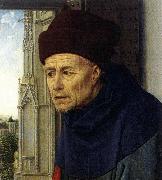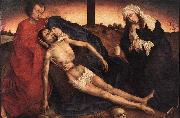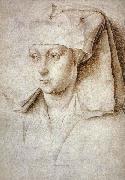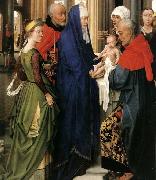
|
Artists
Index
|
||
|
WEYDEN, Rogier van der
|
||
|
St Joseph new21/WEYDEN, Rogier van der-828365.jpg Pintura identificación:: 63864 |
1445 Oil on oak panel, 21 x 18,3 cm Gulbenkian Foundation, Lisbon This fragment was sawn out of the same large altarpiece as the Mary Magdalene in the National Gallery, London. The aged Joseph stood behind the Magdalene; the lower part of his body can still be seen in the fragment. The exterior of the building in which the scene took place was richly ornamented with Gothic decoration, like a church.Artist:WEYDEN, Rogier van der Title: St Joseph Painted in 1401-1450 , Flemish - - painting : religious | |
| |
|
|
|
|
||
|
Lamentation new21/WEYDEN, Rogier van der-369476.jpg Pintura identificación:: 63865 |
1441 Wood, 32,2 x 47,2 cm Mus?es Royaux des Beaux-Arts, Brussels The latest studies attribute this Lamentation directly to Rogier van der Weyden, a pupil of the Master of Fl?malle and one of the most important and influential of the Flemish Primitives. The style and pictorial qualities of the painting match those of other Van der Weyden panels that are documented by archival material. A few authors, however, believe this Lamentation to be by his workshop, because of the various versions that exist of this composition, some of which have definitely been produced by assistants. Van der Weyden had so much work that he left the reproduction of popular compositions like the Lamentation to the other painters in his workshop. Dendrochronological research - the dating of a wooden panel based on the growth rings - places this version at around 1441, i.e. relatively early in the painter's career. Depicted is the lamentation of Christ under the cross, a scene that does not appear as such in the Bible. To the left we see John the Evangelist, barefoot and robed in a red mantle. His right hand supports the Saviour's upper body, which is resting against the Virgin's knee. With his left hand he is comforting Mary. The Mother of God supports her Son's limp head and presses her cheek against his. At Christ's feet Mary Magdalen kneels in veneration, alongside her an ointment pot, her customary attribute. The skull in the foreground refers to the location, Golgotha, literally "place of the skull". Apocryphal texts frequently interpret this as the skull of Adam, whose fall brought death on the human race, and whose original sin Christ died to expiate. The withered trees to the left and right are also taken from medieval Passion stories, certain of which tell that all trees withered when the Saviour gave up the spirit. The emotional intensity of the Lamentation witnesses to the influence of 'devotio moderna', with this type of tableau intended to move the viewer to compassion. Closer contemplation of the Passion would then lead to the imitation of Christ, or place the viewer into the right frame of mind to receive communion.Artist:WEYDEN, Rogier van der Title: Lamentation Painted in 1401-1450 , Flemish - - painting : religious | |
| |
|
|
|
|
||
|
Portrait of a Young Woman new21/WEYDEN, Rogier van der-656378.jpg Pintura identificación:: 63866 |
1440 Silverpoint on prepared paper, 166 x 116 mm British Museum, London The finest of the drawings ascribed to Rogier is the Portrait of a Young Woman. In its freshness of observation and lively expression the drawing comes closest to the painted portrait of another young woman (Staatliche Museen, Berlin), although in contrast to that painting - probably the earliest of the independent portraits by Rogier still extant - the draftsman has modeled the face with much greater plasticity, using light and shade to make shapes like the eyelids appear more rounded and fleshier. This factor in turn links the drawing closely to a portrait of a woman ascribed to the Master of Fl?malle, now in the National Gallery, London, and to the faces in Rogier's earlier Deposition (Prado, Madrid). The strong, bright reflections on the shaded areas of the sitter's throat and cheeks also adopt a method frequently used by Jan van Eyck to heighten the sense of three-dimensionality. By comparison with the chiaroscuro and the powerful three-dimensional style of the drawing, the painted face of the young woman in the portrait appear generally more linear - paradoxically, one might almost say more like a drawing. The draftsman's intention of placing several strong contrasts of light and shade side by side also matches the effects in the Deposition. Like the shaded side of the head of the Virgin, the right-hand side of the portrait drawing shows the alternation of light and very dark areas, and the artist has even shaded the headdress heavily next to the area of reflected light on the sitter's jaw line just below her ear, though this effect is illogical, since if the head-dress is to reflect light it ought to be lit there itself. However, the darkness in the outer area of the drawing, emphasizing the fold at the back of the head-dress, is a genuinely distinctive feature, producing the effect of heavy shadow. There are no such heavy shadows in any painted portrait by Rogier; this pictorial device, creating a sense of space around the figure, first appears in painting around the middle of the century in works by the artist Petrus Christus, who was active in Bruges. Here the draftsman may have created the shadows before drawing the sitter herself, or he may have placed them there to make the back of the headdress retreat into the background - an effect that would also be achieved by the uniform dark ground of a painted portrait. The immediacy of this portrait gives the impression that it was drawn from life. Such an impression is further supported by the fact that only the head and the complicated head-dress are executed in detail, while the upper part of the sitter's body is only lightly indicated; her dress with its patterns of folds could be added later, and leaving it out while the woman herself was being portrayed would have spared her the tedium of sitting for the artist. Such details could easily enough be copied from a painting, but the visible part of the woman's body appears rather awkwardly executed. The right hand on the edge of the picture is particularly jarring, and does not quite connect up anatomically with her shoulder. It is complex in structure, but only half shown, and its clear outline does not make it look like a study from nature. Perhaps the artist completed the lower areas of the portrait later, using a work already in his stock, and experimenting with the composition of his planned painting. All Early Netherlandish portraits were certainly based on drawings from life, for the long process of painting would not have allowed the artist to work from a living model. The Portrait of a Young Woman, outstanding as both a drawing and a portrait, must be one of the very few examples of this genre to have been preserved. Since over and beyond these qualities, the drawing shows similarities with Rogier's painted portraits in its presentation, and with his Deposition in the manner of depicting a head, it could well be by his own hand. It was probably done quite close to the time of the great altarpiece for the Archers of Leuven, while the other (painted) Portrait of a Young Woman must have been executed rather later.Artist:WEYDEN, Rogier van der Title: Portrait of a Young Woman Painted in 1401-1450 , Flemish - - graphics : portrait | |
| |
|
|
|
|
||
|
St Catherine new21/WEYDEN, Rogier van der-748694.jpg Pintura identificación:: 63867 |
1445 Oil on oak panel, 21,7 x 18,6 cm Gulbenkian Foundation, Lisbon This fragment was sawn out of the same large altarpiece as the Mary Magdalene in the National Gallery, London. The face of the saint, probably painted by an assistant, shows weaknesses in the drawing.Artist:WEYDEN, Rogier van der Title: St Catherine Painted in 1401-1450 , Flemish - - painting : religious | |
| |
|
|
|
|
||
|
St Columba Altarpiece new21/WEYDEN, Rogier van der-743877.jpg Pintura identificación:: 63868 |
1455 Oil on oak panel Alte Pinakothek, Munich The picture shows a detail of the Presentation in the Temple, the right panel of the altarpiece executed for the St Columba church in Cologne. According to Mosaic law, all firstborn sons had to be presented to God in the temple. When Mary and Joseph carried out this duty, the pious old Simeon recognized the child as the Redeemer whom, according to a prophecy, he was to see before he died. He thanks God with the words, "Lord, now lettest thou they servant depart in peace, according to thy word." The old prophetess Anna, who also recognizes the Christ, is standing behind Simeon. The servant behind Mary is holding two doves for the sacrifice of purification that followed childbirth. Traces of the late Romanesque church of St. Gereon in Cologne seem to have entered into the architecture of the temple on the right wing - the polygonal rotunda, the gallery, and the small buttresses on the outside.Artist:WEYDEN, Rogier van der Title: St Columba Altarpiece (detail) Painted in 1401-1450 , Flemish - - painting : religious | |
| |
|
|
|
|
||
| Próximo Artista | ||
|
Also Buy::. For Following Paintings / Artists / Products, Please Use Our Search Online: |










